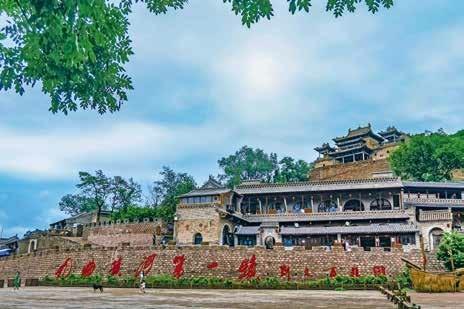在碛口古镇,感受黄河文化
2023-03-19郭晓娟
郭晓娟
由于黃河水流急、落差大、险滩多,行船有局限性,只有小部分条件较好的河段可以勉强走船。古代黄河漕运,“谈碛色变”,没人轻易敢在碛中行船。但是,大同碛的天险却造就了碛口镇的繁荣。
碛口镇,因大同碛得名,位于山西省吕梁市临县城南50公里处,依吕梁山,临黄河水,是中国历史文化名镇。明清至民国时期,碛口镇凭借黄河水运一跃成为北方商贸重镇,享有“九曲黄河第一镇”之美誉,是晋商发祥地之一。
碛口镇是黄河北干流上水运航道的中转站,再有雄心的商贩,到了这里也只能“望碛兴叹”,极不情愿地将满船的货物卸下,再雇驼队经陆路转运到其他地方。日复一日,碛口镇以“水旱码头小都会”的美名传遍南北。鼎盛时期,碛口码头每天来往的船只有150艘之多,由此而生的货栈、票号、当铺等各类店肆多达300家。“驼不完的碛口,装不满的吴城。”当地流传的谚语生动描绘了碛口作为黄河水路枢纽的场景。有学者考证,从清乾隆至民国时期,以碛口镇为中心的商贸网络,东抵京津,南及邯郸,西至兰州,北达包头,可见小镇当时商业之繁盛。
上世纪60年代,随着铁路的开通,碛口码头逐渐失去它曾经的功用,淡出人们的视线,退隐在深远的历史背后。没了旧时的人来人往,更没有了往日的喧哗,这种淡出反而成就了今天的碛口古镇。镇子没有遭到人为破坏,至今仍然保存着丰富的古建筑和文物。尚可辨认的商铺古匾中,清乾隆年间的匾额就至少有5块。
虽历经岁月洗礼,镇子却依然保持原有的样貌。不太宽敞的街道古色古香,两边是高圪台,房檐连着房檐,店铺挨着店铺,明清时期的砖雕、木雕、石刻,风格多样、细腻生动,就连各家门前挂着的灯笼,其穗儿都是用红枣缀就,别有一番风情。

有句话说得好:“世界面食在中国,中国面食在山西。”来到碛口镇,怎能不尝尝地道的山西面。在各种风味的山西传统面食中,碗脱是特别的存在。碗脱是将荞麦面打成糊状,用小碗蒸,因其熟后晾凉可从碗中脱下而得名。食用时,浇上醋、蒜泥、秘制辣椒油,再用小刀划开,吃起来筋软耐嚼、香醇可口。
吕梁一带有一句俗语:“一口莜面一口酒,香得人们口水流。”游客总是分不清荞麦和莜麦,两者虽颜色相近,却是不同的粮食。晋西北人民在长期的生活实践中摸索出了花样繁多的莜面吃法,当地巧妇在搓、推、擀、卷、蒸、煮中,造就了莜面鱼鱼、莜面栲栳栳等美食,而游人也可从中品尝当地浓郁的乡土风味。

古老的石板路,原汁原味的民居,古色古香的店铺,还有头扎白羊肚手巾的老人……原始质朴的生活形态让远来的游客回归内心最真实的宁静。侧耳倾听,仿若转身又遇见了一场繁华:老艄公、货运商猜拳行令声,酒肆、客栈小二招呼客人歇脚声,算盘珠相互碰撞声,驼铃、马蹄声声入耳,一切都显得那么悠远、深沉和厚重。
编辑/刁艳杰

Feel Yellow River Culture in Ancient Town Qikou
The Yellow River has nine curves and eighteen bends. After entering the Jinshan Grand Canyon, you can see two famous natural barriers, i.e. “Hukou Falls and Datongqi”. Datongqi is the second sandbar of the Yellow River, the dangerousness of which has contributed to the prosperity of Qikou Town.
Qikou Town, located 50 kilometers to the south of the seat of Lin County, Lyuliang City, Shanxi, nestling under the Lyuliang Mountain and near the Yellow River, is a famous historic and cultural town of China. From the Ming and Qing Dynasties to the Republic of China, Qikou became a key town of commerce and trade in North China in reliance upon the water transport of the Yellow River. Known as the “First Town by the Yellow River”, it is one of the cradles of Shanxi merchants. In its heyday, there were over 150 ships using the wharf of Qikou every day, which gave birth to 300 shops, including warehouses, exchange shops, and pawnshops. From the Qianlong Period of Qing to the Republic of China, the commerce and trade network centered at Qikou extended eastward to Beijing and Tianjin, southward to Handan, westward to Lanzhou, and northward to Baotou, which demonstrated the flourishing business of the town.
In the 1960s, with the open- ing of railways, the wharf of Qikou gradually lost its function, faded away from the public sight, and became history.
Today, there are still some ancient buildings in Qikou Town. Among the discernible ancient shop signboards, there are at least five from the Qianlong Period.
After undergoing the baptism of time, the town still maintains its original look. Its narrow street is quaint, and lined with high platforms, where houses are connected with one another, and shops are next to one another; the brick carvings, woodcarvings and stone carvings of the Ming and Qing Dynasties have diverse styles, and appear simple and vivid.
Old flagstone paths, original dwellings, quaint shops, elders wearing a white towel tied around their heads... Such a primitive and rustic lifestyle enables tourists from afar to regain true peace of mind.

